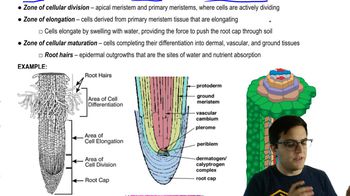Table of contents
- 1. Introduction to Biology2h 42m
- 2. Chemistry3h 40m
- 3. Water1h 26m
- 4. Biomolecules2h 23m
- 5. Cell Components2h 26m
- 6. The Membrane2h 31m
- 7. Energy and Metabolism2h 0m
- 8. Respiration2h 40m
- 9. Photosynthesis2h 49m
- 10. Cell Signaling59m
- 11. Cell Division2h 47m
- 12. Meiosis2h 0m
- 13. Mendelian Genetics4h 44m
- Introduction to Mendel's Experiments7m
- Genotype vs. Phenotype17m
- Punnett Squares13m
- Mendel's Experiments26m
- Mendel's Laws18m
- Monohybrid Crosses19m
- Test Crosses14m
- Dihybrid Crosses20m
- Punnett Square Probability26m
- Incomplete Dominance vs. Codominance20m
- Epistasis7m
- Non-Mendelian Genetics12m
- Pedigrees6m
- Autosomal Inheritance21m
- Sex-Linked Inheritance43m
- X-Inactivation9m
- 14. DNA Synthesis2h 27m
- 15. Gene Expression3h 20m
- 16. Regulation of Expression3h 31m
- Introduction to Regulation of Gene Expression13m
- Prokaryotic Gene Regulation via Operons27m
- The Lac Operon21m
- Glucose's Impact on Lac Operon25m
- The Trp Operon20m
- Review of the Lac Operon & Trp Operon11m
- Introduction to Eukaryotic Gene Regulation9m
- Eukaryotic Chromatin Modifications16m
- Eukaryotic Transcriptional Control22m
- Eukaryotic Post-Transcriptional Regulation28m
- Eukaryotic Post-Translational Regulation13m
- 17. Viruses37m
- 18. Biotechnology2h 58m
- 19. Genomics17m
- 20. Development1h 5m
- 21. Evolution3h 1m
- 22. Evolution of Populations3h 52m
- 23. Speciation1h 37m
- 24. History of Life on Earth2h 6m
- 25. Phylogeny2h 31m
- 26. Prokaryotes4h 59m
- 27. Protists1h 12m
- 28. Plants1h 22m
- 29. Fungi36m
- 30. Overview of Animals34m
- 31. Invertebrates1h 2m
- 32. Vertebrates50m
- 33. Plant Anatomy1h 3m
- 34. Vascular Plant Transport1h 2m
- 35. Soil37m
- 36. Plant Reproduction47m
- 37. Plant Sensation and Response1h 9m
- 38. Animal Form and Function1h 19m
- 39. Digestive System1h 10m
- 40. Circulatory System1h 57m
- 41. Immune System1h 12m
- 42. Osmoregulation and Excretion50m
- 43. Endocrine System1h 4m
- 44. Animal Reproduction1h 2m
- 45. Nervous System1h 55m
- 46. Sensory Systems46m
- 47. Muscle Systems23m
- 48. Ecology3h 11m
- Introduction to Ecology20m
- Biogeography14m
- Earth's Climate Patterns50m
- Introduction to Terrestrial Biomes10m
- Terrestrial Biomes: Near Equator13m
- Terrestrial Biomes: Temperate Regions10m
- Terrestrial Biomes: Northern Regions15m
- Introduction to Aquatic Biomes27m
- Freshwater Aquatic Biomes14m
- Marine Aquatic Biomes13m
- 49. Animal Behavior28m
- 50. Population Ecology3h 41m
- Introduction to Population Ecology28m
- Population Sampling Methods23m
- Life History12m
- Population Demography17m
- Factors Limiting Population Growth14m
- Introduction to Population Growth Models22m
- Linear Population Growth6m
- Exponential Population Growth29m
- Logistic Population Growth32m
- r/K Selection10m
- The Human Population22m
- 51. Community Ecology2h 46m
- Introduction to Community Ecology2m
- Introduction to Community Interactions9m
- Community Interactions: Competition (-/-)38m
- Community Interactions: Exploitation (+/-)23m
- Community Interactions: Mutualism (+/+) & Commensalism (+/0)9m
- Community Structure35m
- Community Dynamics26m
- Geographic Impact on Communities21m
- 52. Ecosystems2h 36m
- 53. Conservation Biology24m
33. Plant Anatomy
Growth
Problem 6`
Textbook Question
Which of the following arise(s), directly or indirectly, from meristematic activity?
a. Secondary xylem
b. Leaves
c. Dermal tissue
d. All of the above
 Verified step by step guidance
Verified step by step guidance1
Understand what meristematic activity is: Meristematic cells are undifferentiated cells in plants that have the ability to divide and differentiate into various types of plant tissues. They are responsible for the growth and development of plants.
Identify the types of meristems: There are two main types of meristems - apical meristems, which are found at the tips of roots and shoots and are responsible for primary growth, and lateral meristems, which are responsible for secondary growth.
Consider secondary xylem: Secondary xylem is produced by the activity of the lateral meristem known as the vascular cambium. It contributes to the thickening of stems and roots.
Consider leaves: Leaves arise from the activity of apical meristems, which contribute to the formation of new shoots and leaves during primary growth.
Consider dermal tissue: Dermal tissue, which includes the epidermis, arises from the differentiation of meristematic cells during both primary and secondary growth processes.
 Verified video answer for a similar problem:
Verified video answer for a similar problem:This video solution was recommended by our tutors as helpful for the problem above
Video duration:
51sPlay a video:
Was this helpful?
Key Concepts
Here are the essential concepts you must grasp in order to answer the question correctly.
Meristematic Activity
Meristematic activity refers to the process by which meristem cells, which are undifferentiated and capable of continuous division, contribute to plant growth. These cells are found in specific regions like the tips of roots and shoots, and they give rise to various tissues and organs, enabling primary and secondary growth in plants.
Recommended video:
Guided course

Active Transport
Secondary Xylem
Secondary xylem is a type of vascular tissue that forms as a result of secondary growth, primarily from the activity of the vascular cambium, a lateral meristem. It is responsible for transporting water and nutrients and contributes to the thickening of stems and roots, commonly seen in woody plants as part of the wood.
Recommended video:
Guided course

Secondary Growth
Dermal Tissue
Dermal tissue is the outer protective layer of a plant, arising from the activity of meristematic cells. It includes structures like the epidermis and periderm, which protect against physical damage and water loss. This tissue plays a crucial role in interfacing with the environment and is essential for plant survival.
Recommended video:
Guided course

Vascular Tissue
Related Videos
Related Practice





















